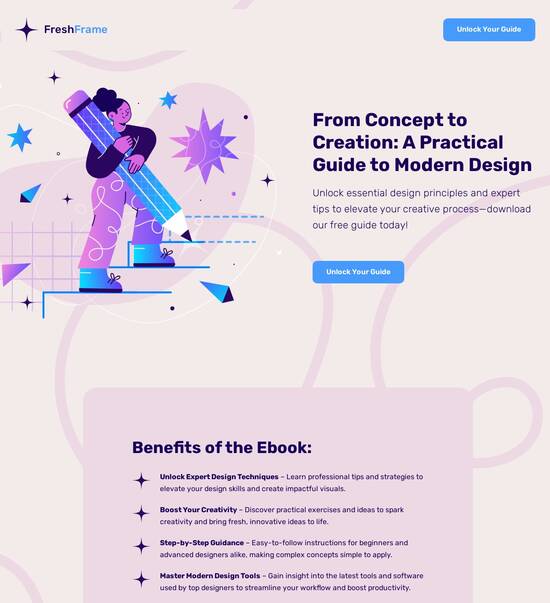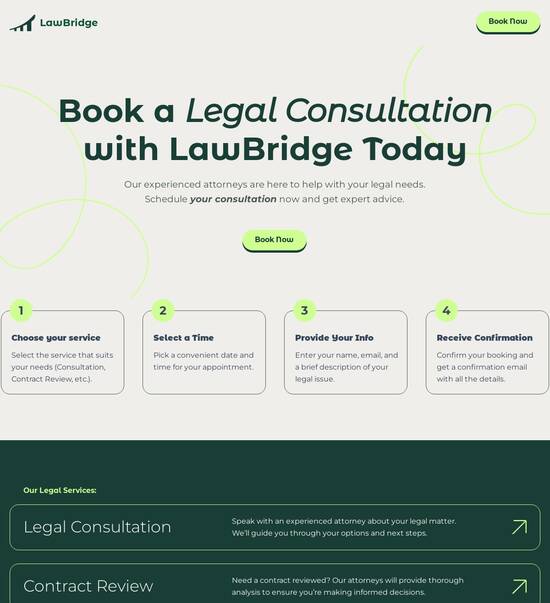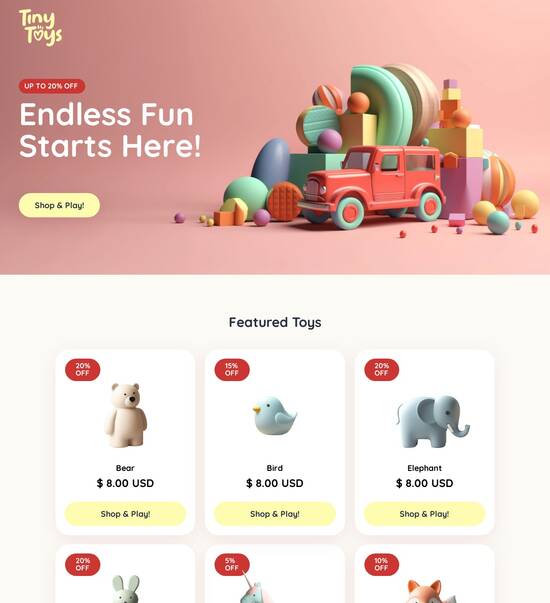
HTML page template for Brand designers
Use TemplateAbout template
Attract clients and showcase your skills with style using our landing page templates for Brand designers. Let's convert those visitors into clients!
Recommended templates

Easy to build without coding
With the intuitive drag-and-drop builder, anyone on your team can create high-converting pages without any knowledge of code or design. Make enhancements to your landing page with custom widgets using Javascript, HTML/CSS, or third-party scripts.

Multiple layouts for any industry and goal
Select from 500+ landing page layouts built to boost conversions across industry-specific scenarios. Customize them by adjusting fonts, adding images, and generating on-brand content with the AI assistant. Quickly scale with Instablocks® and Global Blocks that you can save, reuse, and update globally.

Loads fast and looks polished on any device
Every template is responsive, which means they present professionally on any device and load blazingly fast with our Thor Render Engine. You can also power them up with Google AMP technology to deliver an unparalleled mobile experience and drive higher conversions.

Robust analytics & experimentation
Get real-time updates and reporting across all your devices, showing the number of visitors, conversions, cost-per-visitor, and cost-per-lead. Launch AI-powered experiments, run A/B tests, and use heatmaps to analyze user behavior, then optimize your landing page to maximize conversions.







Easy to build without coding
With the intuitive drag-and-drop builder, anyone on your team can create high-converting pages without any knowledge of code or design. Make enhancements to your landing page with custom widgets using Javascript, HTML/CSS, or third-party scripts.
Multiple layouts for any industry and goal
Select from 500+ landing page layouts built to boost conversions across industry-specific scenarios. Customize them by adjusting fonts, adding images, and generating on-brand content with the AI assistant. Quickly scale with Instablocks® and Global Blocks that you can save, reuse, and update globally.
Loads fast and looks polished on any device
Every template is responsive, which means they present professionally on any device and load blazingly fast with our Thor Render Engine.
Robust analytics & experimentation
Get real-time updates and reporting across all your devices, showing the number of visitors, conversions, cost-per-visitor, and cost-per-lead. Launch AI-powered experiments, run A/B tests, and use heatmaps to analyze user behavior, then optimize your landing page to maximize conversions.
All the features you need to build lead-generating landing pages
Explore more featuresLearn how to build top-performing landing pages for any goal
FAQs
Leading the way in building high-performing landing pages





Maximize your marketing efforts with Instapage landing page templates
Creating effective landing pages is crucial for great digital marketing strategies, especially for professionals in sectors like marketing, tech, and finance. Instapage offers a seamless solution with its powerful landing page and conversion rate optimization (CRO) platform, allowing you to accelerate your campaigns efficiently. With its extensive library of templates and lead generation tools, marketers can enhance their ROI by launching high-converting pages in no time.
Understanding the importance of landing pages
Landing pages serve as the digital handshake between your business and prospects. They are designed with a singular focus: conversion. High-quality landing pages can significantly boost lead generation and sales conversions, making it essential for marketers in the USA to leverage tools like Instapage.
- User Experience (UX) is Key: A well-designed landing page enhances UX, ensuring visitors stay and engage, increasing the likelihood of conversion.
- Targeted Messaging Matters: Clear, concise messaging that speaks directly to your audience can significantly improve conversion rates.
- Optimization Techniques: A/B testing and heatmaps provided by Instapage allow marketers to optimize pages for peak performance.
Getting started with Instapage templates
To build your first landing page with Instapage, follow these simple steps:
- Select a Template: Browse through 100+ high-converting templates and choose one that aligns with your campaign objective.
- Customize with Instablocks: Use Instablocks to easily modify elements and match your brand's style without the need for coding.
- Integrate Lead Generation Tools: Add forms and calls-to-action to encourage visitors to sign up, ensuring you capture essential lead data.
Optimizing your landing pages for conversions
Once your landing page is live, you'll want to ensure it's primed for conversions. Here are some actionable steps:
- Utilize A/B Testing: Experiment with different headlines, images, and calls-to-action to see what resonates best with your audience.
- Analyze User Behavior: Leverage detailed heatmaps to see where users click and how they navigate, allowing you to refine your content.
- Implement Dynamic Text Replacement: Personalize experiences based on incoming traffic sources to boost engagement and conversion rates.
By focusing on optimization, you'll ensure your landing pages are continually performing at their best.
In conclusion, using Instapage's advanced features enables marketers to create optimized landing pages that drive measurable results and maximize ROI.
Ready to transform your digital marketing strategy? Start using Instapage today and unlock the potential of your campaigns.
HTML page templates: A revolutionary tool for brand designers
The essence of HTML page templates
HTML (Hypertext Markup Language) is the foundational language used to create and structure content on the web. It serves as the backbone for web design, providing the essential elements that form web pages. By using HTML, designers can ensure their content is not only visually appealing but also semantically organized, which plays a crucial role in enhancing user experience. A well-structured HTML document makes it easier for browsers to interpret and display the page, while search engines can effectively crawl the content, thus improving search rankings.
Page templates are an integral aspect of HTML, particularly in brand design. They streamline the web design process by providing a pre-designed framework that can be customized to suit specific branding needs. This efficiency allows designer teams to focus more on creativity rather than the nitty-gritty of coding. The key distinction between using a custom design and template customization lies in the level of personalization; while custom designs offer unique assets from scratch, templates allow for tweaks and adaptations within a structured layout, making them both time and cost-effective.
The anatomy of a robust HTML page template
A strong HTML page template consists of several critical components that work in harmony to create effective web pages. The basic structure of an HTML template includes the header, body, and footer. The header typically contains navigation links, branding elements, and meta-information. The body is the heart of the template, housing the main content, images, and other media. Finally, the footer usually houses copyright details and additional links, completing the site’s informational architecture.
Beyond HTML, Cascading Style Sheets (CSS) play a significant role in the aesthetic appeal of a template and its responsiveness across different devices. High-quality web design templates must be mobile-responsive, allowing seamless viewing experiences on smartphones and tablets. They also need to ensure cross-browser compatibility so that the site looks and functions optimally, regardless of the browser used. Additionally, employing SEO-friendly markup within HTML ensures that the content can be easily indexed by search engines, thus enhancing visibility for brand websites.
HTML structure: ensures the foundational layout and information hierarchy.
CSS styling: enhances design and responsiveness across various devices.
Mobile responsiveness: optimizes layouts for smartphone and tablet users.
Cross-browser compatibility: guarantees a uniform experience on different browsers.
SEO-friendly markup: supports higher search engine ranking and visibility.
Types of HTML templates every brand designer should know
Brand designers can leverage various types of HTML templates to cater to the specific needs of different businesses. Business-focused templates are crucial for companies that want to emphasize professionalism and reliability. These templates often feature dedicated sections for testimonials, services, and contact details to enhance client engagement. Portfolio templates, on the other hand, enable creative professionals to showcase their work in an appealing manner, enhancing personal branding and artistic expression.
For brands looking to sell products or services online, e-commerce HTML templates are essential. These templates not only display product catalogs but also include features that facilitate shopping cart functionality and secure payment options. With a focus on driving sales, they are designed to engage users effectively and provide a smooth shopping experience. Furthermore, block templates represent a unique solution by allowing designers to create modular layouts. Understanding how to effectively combine different blocks can lead to the creation of highly customized and unique presentations for web content.
Business-focused templates: emphasize professionalism and reliability.
Portfolio templates: facilitate the showcasing of creative work.
E-commerce templates: designed for seamless online sales and user engagement.
Block templates: offer modular flexibility for unique layouts.
The importance of visual and functional design elements
Integrating unique design aesthetics with HTML templates is crucial for brand representation. Color schemes, typography, and imagery should align with a brand’s identity to create cohesive and memorable user experiences. Many templates offer customization options, allowing designers to modify these visual elements to reflect their branding effectively. The strategic use of colors and font styles is not just about aesthetics; it also influences how users perceive the brand and can foster a stronger emotional connection.
Usability and user experience are equally important when crafting intuitive navigation within templates. Best practices include creating clear paths for users, ensuring that important information is easily accessible, and maintaining a logical flow throughout the website. The layout plays a significant role in user engagement; for example, using visual hierarchies helps direct users’ attention to essential content, ultimately influencing conversion rates. By prioritizing both visual appeal and functionality, brand designers can create templates that resonate well with their target audiences.
Customization: tailoring HTML page templates to your brand
Once the right HTML page template is chosen, utilizing the template editor for personalization becomes essential. Many modern template editors come equipped with user-friendly features that streamline this process. Designers can easily swap out images, modify text, and adjust layout settings without needing extensive coding knowledge. A step-by-step approach to customizing the chosen template empowers designers to make it their own while still benefiting from the structural advantages of a template.
For those familiar with CSS, further enhancing template functionality is possible. Implementing CSS effectively can improve the overall design without compromising load speed. Simple tricks, such as optimizing image sizes and using efficient selectors, can lead to faster page loads and improved user experience. Custom CSS can also help in creating unique hover effects, transitions, and animations that set a brand apart from competitors. Learning to balance these technical enhancements while maintaining template integrity is crucial for achieving optimal results.
Streamlining content creation and template management
Efficient content strategies are vital for leveraging HTML templates effectively. One way to optimize content layout is by utilizing pre-designed blocks that come with many templates. This feature simplifies the process of organizing content while ensuring visual coherence across the site. Furthermore, integrating dynamic content can keep a website fresh and engaging, encouraging visitors to return frequently and explore new offerings.
Template management best practices also play a significant role in effectively utilizing HTML templates. Organizing and categorizing templates based on specific projects or brand needs can save time and ensure quick access when required. Regular updates and maintenance are necessary to adapt to evolving brand aesthetics and functionality, making it easier to keep the site relevant and user-friendly as trends shift.
Utilize pre-designed blocks for content layout optimization.
Integrate dynamic content to keep the site fresh.
Organize templates based on projects for easy access.
Regularly update templates to maintain relevance.
Practical applications and case studies
The practical application of HTML templates can be seen across multiple successful brand design projects. Analyzing these case studies reveals the effectiveness of using the right templates in enhancing brand visibility and engagement. For example, a marketing agency utilized an e-commerce HTML template to revamp its client's online store. The result was a significant boost in sales and customer satisfaction, showcasing how an effectively designed template can transform a brand’s digital footprint.
Moreover, understanding the transformation process from concept to launch highlights the importance of each stage of template usage. From initial design brainstorming to the final testing of templates, every step can be critical for success. Being aware of common pitfalls, such as overlooking mobile responsiveness or neglecting SEO aspects, can help designers avoid potential setbacks during implementation.
Future trends in HTML templates for brand designers
As technology continues to evolve, emerging trends significantly influence the world of web design. AI and machine learning technologies are increasingly shaping template designs, allowing for automated personalization based on user behaviors and preferences. The rise of interactive and immersive templates, which engage users in new ways, is becoming more common, challenging designers to think creatively in how they present information.
Looking ahead, the evolution of HTML templates in branding will likely be influenced by changing user preferences and advancements in web standards. Brand designers must adapt to these trends to remain relevant and competitive in the marketplace. Staying informed about technological advancements and embracing new tools will empower designers to continue creating impactful web experiences that resonate with users.
Final thoughts on empowering brand designers through HTML templates
Well-designed HTML page templates can transform the approach that brand designers take in their workflows. By using templates, designers benefit from streamlined processes while retaining the ability to customize and express brand identity. Balancing creativity with structure is key to maximizing the potential of templates in web design, and talented designers can produce remarkable results which resonate with audiences.
Ultimately, aligning HTML templates with brand vision facilitates innovation and fresh perspectives in design. Encouraging continuous learning and adaptation to emerging web standards can ensure brand designers remain on the cutting edge of effective web design solutions.
Ready to skyrocket conversions?
Supercharge your ad campaigns with high-performing landing pages
Get started














